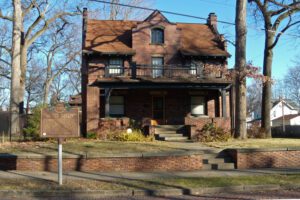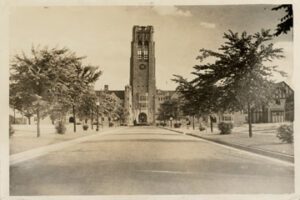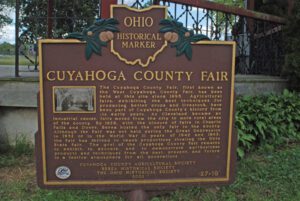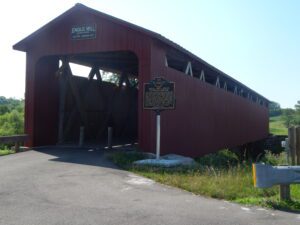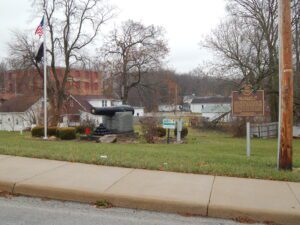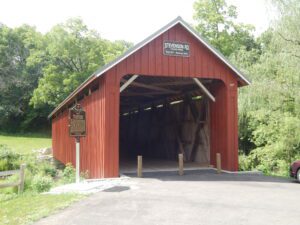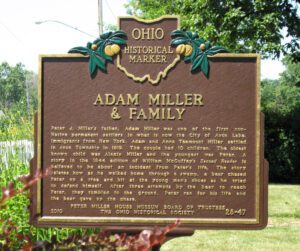, OH
Akron, an industrial boomtown in the early twentieth century, grew in population nearly fivefold between 1900 and 1920. As the city industrialized, middle class residents sought homes on West Hill, away from the smoke and soot of heavy industry on the East Side. The Hall Park Allotment Historic District in West Hill represents a notable early twentieth century neighborhood. Developed by Philander Hall between 1902 and 1919 during the height of Akron’s “rubber boom,” it consists of several houses representing the picturesque styles of the period, including the American Foursquare, Craftsman, Colonial, and Medieval Revival Styles. With its gently curving brick streets, hilly topography, and mature trees, the Hall Park Allotment Historic District evokes the feeling of a distinct period of time in Akron’s history and constitutes a neighborhood of distinctive historical character and architectural merit.
, OH
The Toledo University of Arts and Trades was established in 1872 with an endowment of 160 acres of land from Jesup W. Scott, local pioneer, publisher, and real estate broker. Scott envisioned Toledo as the “Future Great City of the World” and wanted an institution to train young people to fulfill their roles in the city’s bright future.
, OH
The Cuyahoga County Fair, first known as the West Cuyahoga County Fair, has been held at this site since 1895. Agricultural fairs, exhibiting the best techniques for producing better crops and livestock, have been part of Cuyahoga County’s history from its early years. As Cleveland became an industrial center, fairs moved from the city to more rural areas of the county. By 1928, with the closure of fairs in Chagrin Falls and Dover, Berea hosted the only fair in the county. Although the Fair was not held during the Great Depression in 1932 or in the World War II years of 1942 and 1943, the Fair has thrived to reach proportions rivaling the Ohio State Fair. The goal of the Cuyahoga County Fair remains to exhibit, to educate, and to demonstrate agribusiness products and techniques from the past, present, and future in a festive atmosphere for all generations.
, OH
Built in 1877 and spanning 136 feet, the Engle Mill Road Covered Bridge carried vehicular traffic until 2003. The bridge is named after the nearby Levi Engle Mill. It is one of a few dozen Smith Truss bridges in the United States. The Smith Bridge Company manufactured the bridge using the Smith Truss patent, invented by founder, Robert W. Smith. The company originated in Tippecanoe City, Ohio and relocated to Toledo, where it was purchased by the Toledo Bridge Company in 1890. Smith died in 1898 at the age of 63, leaving a legacy of unique bridges.
, OH
Lester Allan Pelton, “the Father of Hydroelectric Power,” was born on September 5, 1829, a quarter of a mile northwest of this site. He spent his childhood on a farm a mile south of this site and received his early education in a one-room schoolhouse that once sat north of this site. In the spring of 1850, he and about twenty local boys, left for California during the great gold rush west. Pelton did not find gold, but instead invented what was commonly known as “the Pelton Water-Wheel,” which produced the first hydroelectric power in the Sierra Nevada Mountains in California in 1887. The Water-Wheel was patented on August 27, 1889. Currently variations of it are still commonly used to generate electric power throughout the world. Pelton died in California on March 14, 1908. He is buried at Maple Grove Cemetery in Vermilion.
, OH
The roots of Huntersville began when John and Elizabeth Hilliard purchased this former Shawnee tribal land in 1797 from Ohio’s largest land speculator Judge John Symmes. When Symmes defaulted on his payments, the Hilliards found themselves repurchasing their own land from the federal government. These uncertain land claims defeated their 1799 attempt to found “Hilliardstown.” David Hunter purchased the abandoned village site in 1833. He re-surveyed the land in 1838 creating an eighteen lot, two street village that he named Huntersville. The village incorporated in 1848, but was annexed by the neighboring city of Piqua in 1893. At the time Huntersville had a population of over 760, its own school system, a volunteer fire department, gas lights, and an assortment of saloons, boarding houses, and grocery stores.
, OH
Built in 1877 and spanning approximately ninety-five feet, the Stevenson Road Covered Bridge carried vehicular traffic until 2003. It is one of the few Smith truss bridges left in the United States. The Smith Bridge Company manufactured the bridge using various patents of the company, which were secured by its founder, Robert W. Smith. The company originated in Tippecanoe City, Ohio (Tipp City) and later relocated to Toledo. In 1890 the Toledo Bridge Company Purchased the company from Smith. Robert Smith died in 1898 at the age of sixty-five leaving behind a legacy of unique covered bridges.
, OH
The Peter J. Miller House was constructed around 1830 and is one of the last remaining pre-Civil War lakefront houses in Lorain County. The architecture is Greek Revival. Peter Miller married Ruth Houseworth in 1828. They had five children. In 1851 Peter Miller died and it’s believed that his family continued to reside on the property until 1925. The City of Avon Lake purchased the property in 1962. The house was opened for tours, and restoration proceeded, as funds were available. In 1975 the water heating system burst and caused extensive damage. In 1985 a new committee took over and was successful in restoring the house. Volunteer trustees have overseen the operation of the house as a museum since September 1989.


